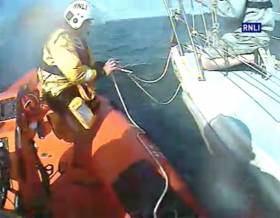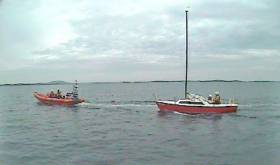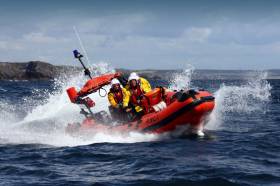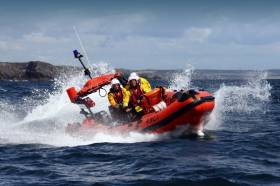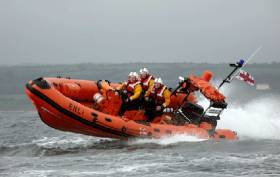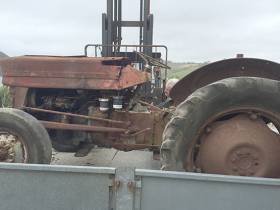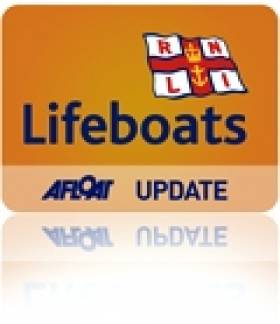Displaying items by tag: Union Hall
#RNLI - Union Hall RNLI were alerted by Valentia Coast Guard at 3.24pm yesterday (Saturday 22) to a report of a 30ft yacht with two sailors gone aground at the middle danger in Glandore Harbour, West Cork.
The lifeboat launched and was underway to the yacht at 3.33pm in favourable weather conditions, with a slight breeze from the north.
While en route to the scene, a member of the public notified the lifeboat station that the yacht had refloated safely. The volunteer crew subsequently spoke to the sailors, who were happy to continue sailing.
Union Hall RNLI deputy launch authority Peter Deasy said: “While a lot of activity is taking place in Glandore Harbour this week with the Glandore Classic Boat Regatta, we advise people to be alert, obey navigation aids and respect the water. If you see someone in trouble dial 999/112 and ask for the coastguard.”
#RNLI - Union Hall RNLI went to the aid of a yacht with two people onboard yesterday evening (Thursday 13 July) after the vessel got into difficulty half a mile east of Castlehaven Harbour in West Cork.
The volunteer lifeboat crew was alerted at 5.26pm by Valentia Coast Guard to reports of a 28ft yacht that had fouled its propeller.
The lifeboat was launched and on scene within 20 minutes. Weather conditions at the time were good and the sea was calm.
Two whale watching boats, Voyager and Liscannor Star, stood by the casualty vessel until the lifeboat crew arrived and worked with the two men onboard to attach a tow line to the yacht.
The lifeboat then towed the yacht to the safety of Reen Pier before returning to Union Hall, joined by a pod of dolphins along the way.
Speaking following the callout, Union Hall RNLI deputy launching authority Peter Deasy said: “We were happy to assist the sailors this evening on what was the first callout for our only female crew member, Sarah Browne.”
Clifden, Union Hall Lifeboats Launch To Yachts In Difficulty
#RNLI - Clifden RNLI prepared for launch at 7.16pm on Tuesday evening (20 June) to assist a yacht gone aground in the Clifden Bay area.
Helm David Barry, along with volunteer crew Ian Shanahan, Brian Ward and Owen Hayes on the Atlantic 85 inshore lifeboat, quickly located the 23ft yacht stranded on a rocky piece of shoreline.
The lone sailor on board was uninjured, and after communication with the lifeboat crew, it was agreed to tow the yacht from its location.
Clifden’s all-weather lifeboat and the Rescue 118 helicopter from Sligo were also requested to assist, but both were stood down when the yacht was successfully under tow.
Speaking following the callout, Barry said: “We returned the sailor and his yacht to a mooring in Clifden Bay and were glad to have been able to respond so quickly to a vessel in need of assistance.”
Meanwhile in West Cork, Union Hall RNLI were requested at 8.32pm to provide assistance to a 21ft yacht with two people on board, seven-and-a-half miles south of Adam Island at the entrance to Glandore Harbour.
The Union Hall inshore lifeboat Margaret Bench of Solihull launched within seven minutes and headed to the yacht, where sea conditions were calm but the yacht had encountered a squall, which resulted in the loss of a sail and instruments.
The lifeboat volunteers made contact with the two people on board, ensured there was no injuries, attached a tow line and towed the yacht back to the safety of Union Hall Pier.
Speaking after the callout, Union Hall RNLI lifeboat operations manager John Kelleher said: “The crew of the yacht made the right decision to contact the coastguard sooner rather than later.
“Always carry a means of communication, be it VHF or mobile phone. It is very important, especially at nighttime.”
Union Hall Lifeboat Starts Summer Season With Two Callouts
#RNLI - It’s shaping up to be the start of a busy season for the volunteer lifeboat crew at Union Hall RNLI with two callouts in less than two weeks.
On Saturday 8 April, the inshore lifeboat launched at 12.14pm to Rabbit Island with reports of two sheep spotted on a low-lying cliff at the side of the island.
The crew went to the island to access the situation, and to eliminate the risk of members of the public trying to assist the sheep.
The volunteers went ashore and helped the sheep back onto the island, left them grazing and returned to Union Hall pier.
More recently, on Monday 17 April, Union Hall RNLI was requested by Valentia Coast Guard at 9.26pm to reports of two red flares spotted near Adam Island at the mouth of Glandore Harbour.
Launching five minutes later, the lifeboat crew proceeded to the scene and were joined by the Irish Coast Guard helicopter Rescue 117 from Waterford and Toe Head/Glandore Coast Guard Unit, who also had their shore crew assist.
A thorough search was conducted of the inner harbour and islands at the mouth of Glandore Harbour. Nothing was found and Union Hall RNLI was stood down at 10.53pm.
Speaking following the callouts, Pamela Deasy, Union Hall RNLI volunteer lifeboat press officer said: “As we approach the summer season we would remind everyone to respect the water and remember if you see anything suspicious or someone in trouble over the coming months, call 112/999 and ask for the coastguard.”
Union Hall Lifeboat Brings 15 Kayakers To Safety Off Castlehaven
#RNLI - A group of kayakers were brought to safety on Thursday night (18 August) by Union Hall RNLI after they got into difficulty during a night-time kayaking expedition off Castlehaven in West Cork.
The alarm was raised by one of the kayakers after two of the party became separated and the group requested assistance to make their way back to shore.
Union Hall RNLI's inshore lifeboat was launched at 10.45pm and proceeded to the scene, where they learned that the two kayakers originally thought missing had made it to safety on shore and the rest of the group requested assistance to get back to land.
It was decided to take the group off their kayaks and bring them onto the lifeboat before bringing them the short distance to Reen Pier.
The 15 people were helped onboard the Atlantic 85 lifeboat while their kayaks were towed back to shore.
"This was a large group for our inshore lifeboat to assist and our volunteer crew did well in ensuring that everyone was taken onboard quickly and safely," said Union Hall RNLI lifeboat operations manager John Kelleher.
"The weather conditions were challenging for the lifeboat crew to get from their base in Union Hall over to Castlehaven but thankfully conditions on scene were much calmer.
"With the call for help coming in quite early and the lifeboat crew on scene quickly, we were able to get the situation under control in a short time with everyone accounted for and safely brought ashore."
Union Hall Lifeboat Launches To Yacht Off Glandore Harbour
#RNLI - Union Hall RNLI was tasked by Valentia Coast Guard at 6.14pm on Monday (20 June 2016) to reports of a yacht in difficulty with a broken tiller three-and-a-half miles south of Glandore Harbour.
The volunteer lifeboat crew launched at 6.20pm and on arrival at the scene they escorted the yacht to Eve Island before establishing a tow and continuing on Union Hall pier, where the yacht was tied up at 7.17pm.
Union Hall RNLI deputy launching authority Jim Moloney said: "There was no immediate danger to the yacht or the crew but they were right to request assistance as soon as their tiller broke."
A UK Agricultural Engineering lecturer is to travel to Union Hall, Cork this July to undertake a challenge to rebuild a Massey Ferguson tractor in 24-hours, with a little help from colleagues and friends. The tractor will then be raffled off to raise funds for Union Hall RNLI.
Michael O’Sullivan is a lecturer in Wiltshire College, England and has a home in Union Hall, where his father was born. Michael approached Union Hall RNLI some months ago with his unique fundraising idea and asked them if they could source a dilapidated tractor for the 24-hour challenge. They could and they did and plans are now in place for the 24-hour rebuild on Wednesday 13 July 2016 on Keelbeg Pier in Union Hall.
Commenting on the novel fundraiser Pamela Deasy, Union Hall RNLI Lifeboat Press Officer said, ‘This wonderful project, to be carried out with the help of the local community, will raise much needed funds for Union Hall RNLI. We are passionate about three things in this part of the world; the sea, our sport and the land and this project encompasses two out of three of them.
‘Some years ago we saw a need for a lifeboat service here and we approached the RNLI to consider our proposal. Even before there was a lifeboat in Union Hall the community raised funds for the charity. The awful tragedy with the Tit Bonhomme in 2012 brought home to us how unpredictable the sea can be and how many families have lost loved ones to it. In 2014 the RNLI established a lifeboat station in Union Hall with an Atlantic class inshore lifeboat on a two year trial. Since that time the volunteer lifeboat crew has responded to 17 callouts and brought 21 people to safety.’
The parts for the tractor are being donated to the project by AGCO and it is hoped to be able stream the 24-hour challenge live online.
Union Hall Lifeboat Launches To Reports Of Flashing Light
#RNLI - Union Hall RNLI was paged at 6.31am this morning (Thursday 15 October) to reports of a flashing strobe light south of Rabbit Island at the entrance to Glandore Harbour.
Union Hall’s inshore lifeboat Maritime Nation launched at 06.39 am to investigate after two reported sightings of a flashing light in the water, one from a member of the public and another from a member of Glandore/Toe Head Coast Guard.
On inspecting the scene, the flashing light was spotted, and turned out to be an EPIRB (Emergency Position Indicating Radio Beacon).
The volunteer crew then commenced a search of the water surrounding the area. They found nothing else and returned to the lifeboat station with the EPIRB.
"You can never be too careful even at this time of year," said Jim Moloney, Union Hall RNLI deputy launch authority. "The member of the public was correct to report this sighting and no time was wasted in getting a search of the area."
Union Hall Lifeboat Rescues Five From French Yacht
#RNLI - Union Hall RNLI rescued five men after their yacht was in danger of hitting rocks off the coast of West Cork on Friday evening (26 June).
The volunteer lifeboat crew was alerted shortly after 5pm following a report from the Irish Coast Guard that a 54ft French yacht, with five men onboard, was dragging an anchor on a lee shore in the inner harbour in Glandore village.
The inshore lifeboat, helmed by Stephen Hurley and with crew members Johnny McKenna and Sean McCarthy, launched at 5.15pm and was on scene minutes later. Weather conditions at the time were described as good with a Force 4-5 westerly wind blowing.
Once on scene, the lifeboat crew observed that the vessel was in danger of hitting rocks after its propeller had got tangled in a rope. The yacht’s crew had put out an anchor but it then started to drag on a lee shore.
Having assessed the situation, one lifeboat crew member went aboard the yacht before a towline was quickly established to divert the vessel from hitting the rocks.
The lifeboat crew then proceeded to bring the vessel and the five men onboard safely back to Union Hall.
Speaking following the callout, Union Hall RNLI deputy launching authority Jim Moloney said: "The quick response of the lifeboat crew prevented a more serious situation developing this evening and I would like to commend our volunteers for using their skills and training to bring the yacht out of danger."
#rnli – Lifeboat crew with Union Hall RNLI had their third callout in a week when launched on Saturday afternoon (13 June 2015) to bring a 44–ft yacht with two crew onboard to safety after it reported engine problems off Galley Head.
The crew onboard the yacht raised the alarm with Valentia Coast Guard after they realised they were expiring severe engine trouble and they feared they would not be able to bring the vessel to safety. The Union Hall lifeboat was launched at 4.44pm and was on scene in thirty minutes.
Conditions were overcast with an easterly wind when the lifeboat took the yacht under tow into Glandore Harbour and ensured the two men were safely ashore.
Commenting on the callout Union Hall RNLI Deputy Launching Authority Peter Deasy said, 'It's been a busy week for the volunteer lifeboat crew with three callouts. Thankfully everyone was safe. Engine problems can happen to anyone and it is always advisable to call for assistance. The crew of the yacht were concerned that they would have difficulty making it safety to shore alone. The weather was not ideal in this case and they made the right call.
Yesterday's callout follows on from two incidents earlier in the week when the Union Hall RNLI crew launched following reports that a paddle boarder had disappeared from view and before that when an 18ft pleasure boat got into difficulty off the coast of West Cork.



























